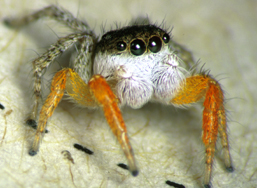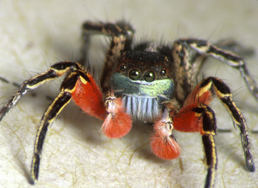|
|
|
|
|
|
|
|
|
|
|
|
|
|
|
|
|
|
|
|
|
|
|
|
|
|
|
|
|
|
|
|
 |
 |
|
|
|
|
Habronattus (Araneae: Salticidae) of
California including Baja
|
|
|
|
|
|
|
|
|
|
|
|
|
|
|
The genus Habronattus is a wonderfully diverse group of jumping spiders. With over 90 described species in the genus, the group represents one of the more species-rich spider genera in the New World. Besides having many species, Habronattus is perhaps most remarkable in diversity of male morphological ornamentation, male courtship behavior, and habitat preference. It is almost certainly true that many less-obvious aspects of these spiders (e.g., specifics of the visual system, female preference) are equally diverse. This page provides a primarily visual introduction to Habronattus species which can be found in California, including the Baja Peninsula of Mexico. A more general introduction to the genus can be found on the Tree of Life. Some of the information included in this page comes from the publications of Charles Griswold (see references below); most of the information provided is based on personal experience of the site authors, with acknowledgments.
With a fauna including over thirty species, the Habronattus of California plus Baja comprises a representative cross-section of the entire genus. This diversity of Habronattus mirrors the diversity of geographic area itself, which includes a tremendous variety of habitats ranging in elevation from below sea level to over 4000 meters. Habronattus spiders can be found in essentially all of these habitats, typically as ground-dwellers, but also as vegetation-dwellers. Most mid-elevation sites with a reasonable wealth of microhabitats will have more than five species living in close proximity. Eighteen species are (essentially) endemic to the region, several of which are currently undescribed. It is almost certain that additional collecting will reveal more new species, particularly in under-collected areas of Baja. |
|
|
|
|
|
|
|
|
|
|
 |
|
|
|
|
|
|
|
|
|
|
|
|
|
Average Size of an Adult
Habronattus = 5 - 6 mm
[----]
|
|
|
|
|
|
|
|
|
|
To learn more about CA Habronattus, or to simply see more nice spider photographs, follow one of several links. Distributional, natural history, and identification information specific to any single species can be found by linking to pages devoted to Habronattus species groups. Members of a species group are evolutionarily related, sharing many characteristics which provide a natural system of organization. Almost all photographs are of adult males, which provide the most character information for species separation. A small gallery of female Habronattus photos is included for completeness. The habitats and observation link includes a photographic gallery of habitats where various Habronattus have actually been collected. This link also includes tips on observing and collecting these spiders, a rather satisfying (but sometimes difficult) activity. The evolutionary "gold mine" link highlights some of the interesting evolutionary patterns observed in CA Habronattus, including evidence for hybridization, fine scale ecological divergence, and geographic variation in characters related to sexual signaling. |
|
|
|
|
|
|
|
|
|
|
|
|
|
|
|
|
|
|
Griswold References:
Griswold, C.E. 1977. Biosystematics of Habronattus in California . M.Sc. Thesis, Univ. of California, Berkeley.
Griswold, C.E. 1987. A revision of the jumping spider genus Habronattus F.O.P.-Cambridge (Araneae; Salticidae), with phenetic and cladistic analyses. University of California Publications in Entomology. Volume 107: pp. 1-345.
|
|
|
|
|
|
|
|
|
|
|
|
|
|
|
|
|
|
|
Acknowledgments:
Many persons helped the authors in collecting Habronattus of California and Baja, including S. McMahon, P. O'Grady, and D. Miller (Baja), J. Hedin and D. Maddison (CA).
Field work was funded by NSF and the David and Lucille Packhard Foundation.
We thank T. Perez (UNAM) for collaboration with Mexican Habronattus studies and permits.
|
|
|


